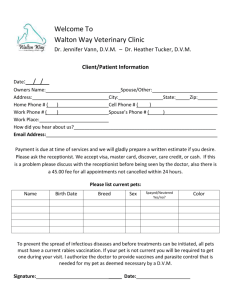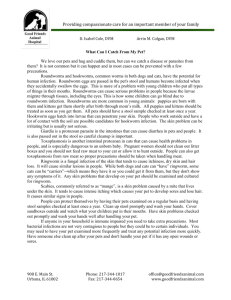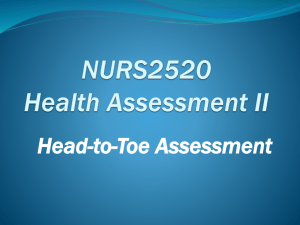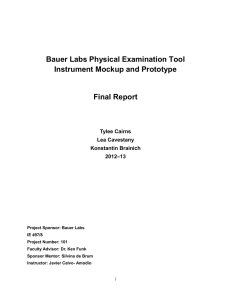your pet`s comprehensive physical examination
advertisement
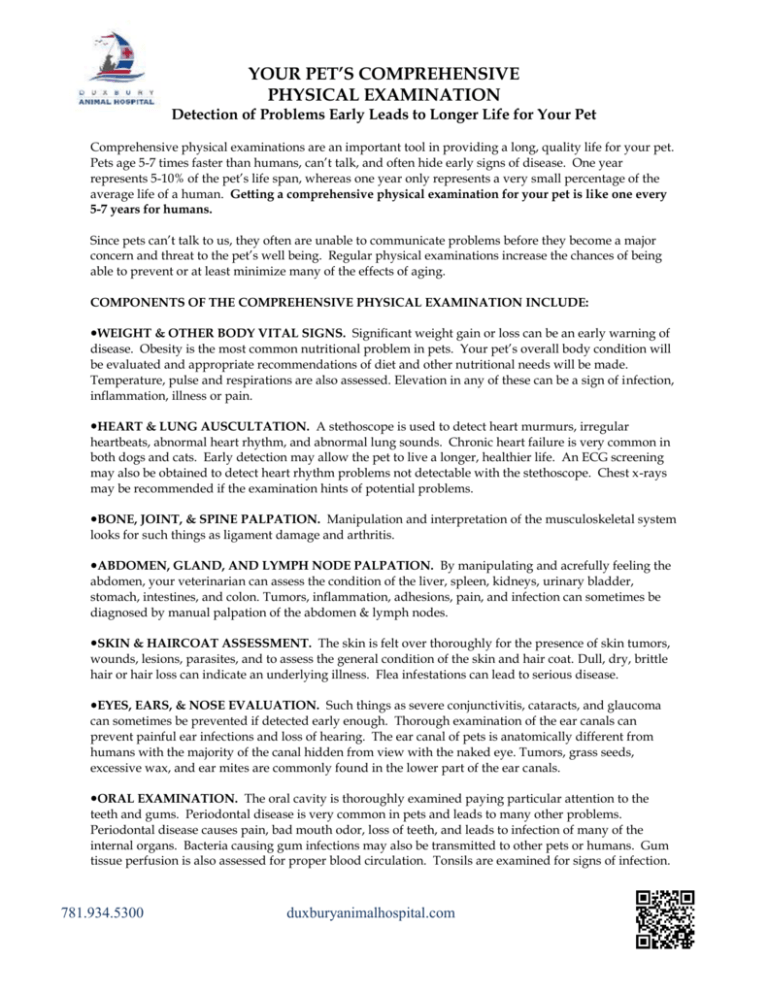
YOUR PET’S COMPREHENSIVE PHYSICAL EXAMINATION Detection of Problems Early Leads to Longer Life for Your Pet Comprehensive physical examinations are an important tool in providing a long, quality life for your pet. Pets age 5-7 times faster than humans, can’t talk, and often hide early signs of disease. One year represents 5-10% of the pet’s life span, whereas one year only represents a very small percentage of the average life of a human. Getting a comprehensive physical examination for your pet is like one every 5-7 years for humans. Since pets can’t talk to us, they often are unable to communicate problems before they become a major concern and threat to the pet’s well being. Regular physical examinations increase the chances of being able to prevent or at least minimize many of the effects of aging. COMPONENTS OF THE COMPREHENSIVE PHYSICAL EXAMINATION INCLUDE: WEIGHT & OTHER BODY VITAL SIGNS. Significant weight gain or loss can be an early warning of disease. Obesity is the most common nutritional problem in pets. Your pet’s overall body condition will be evaluated and appropriate recommendations of diet and other nutritional needs will be made. Temperature, pulse and respirations are also assessed. Elevation in any of these can be a sign of infection, inflammation, illness or pain. HEART & LUNG AUSCULTATION. A stethoscope is used to detect heart murmurs, irregular heartbeats, abnormal heart rhythm, and abnormal lung sounds. Chronic heart failure is very common in both dogs and cats. Early detection may allow the pet to live a longer, healthier life. An ECG screening may also be obtained to detect heart rhythm problems not detectable with the stethoscope. Chest x-rays may be recommended if the examination hints of potential problems. BONE, JOINT, & SPINE PALPATION. Manipulation and interpretation of the musculoskeletal system looks for such things as ligament damage and arthritis. ABDOMEN, GLAND, AND LYMPH NODE PALPATION. By manipulating and acrefully feeling the abdomen, your veterinarian can assess the condition of the liver, spleen, kidneys, urinary bladder, stomach, intestines, and colon. Tumors, inflammation, adhesions, pain, and infection can sometimes be diagnosed by manual palpation of the abdomen & lymph nodes. SKIN & HAIRCOAT ASSESSMENT. The skin is felt over thoroughly for the presence of skin tumors, wounds, lesions, parasites, and to assess the general condition of the skin and hair coat. Dull, dry, brittle hair or hair loss can indicate an underlying illness. Flea infestations can lead to serious disease. EYES, EARS, & NOSE EVALUATION. Such things as severe conjunctivitis, cataracts, and glaucoma can sometimes be prevented if detected early enough. Thorough examination of the ear canals can prevent painful ear infections and loss of hearing. The ear canal of pets is anatomically different from humans with the majority of the canal hidden from view with the naked eye. Tumors, grass seeds, excessive wax, and ear mites are commonly found in the lower part of the ear canals. ORAL EXAMINATION. The oral cavity is thoroughly examined paying particular attention to the teeth and gums. Periodontal disease is very common in pets and leads to many other problems. Periodontal disease causes pain, bad mouth odor, loss of teeth, and leads to infection of many of the internal organs. Bacteria causing gum infections may also be transmitted to other pets or humans. Gum tissue perfusion is also assessed for proper blood circulation. Tonsils are examined for signs of infection. 781.934.5300 duxburyanimalhospital.com


